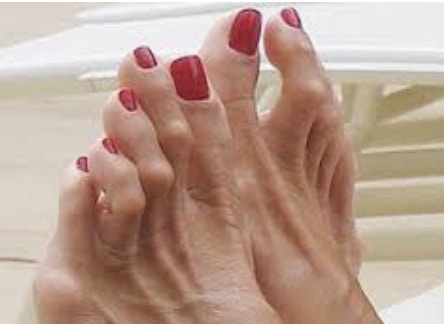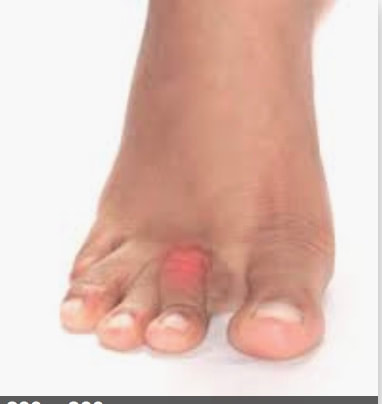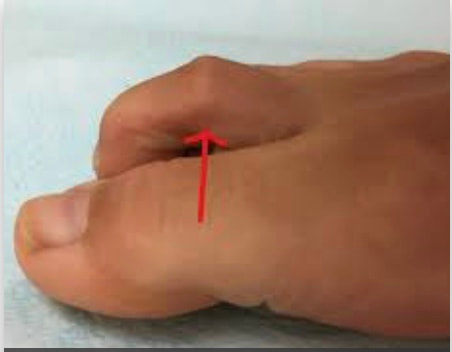WHAT ARE HAMMERTOES?
In general, the term "hammer toe" describes a buckling of any of the toe joints. Joins at the end or middle of the toe, a well as the joint near the ball of the foot, may be affected. Toe joints usually curl because of a muscle imbalance or tight tendons. Hammer toes vary in severity and in the number of joints and toes involved.
Your little toes help to balance and propel your body when you move. As your foot flattens, the little toes bend to grip the ground. Then they straighten, acting like levers to help push your foot so you can walk, run, or dance. But if the front of your foot is wide, you may develop a hammer toe. Over time, these toes may hurt and make movement more difficult. But you don't have to live with pain. With Dr.Karr's help, even sever hammer toes can usually be treated so you can move more easily.
Physical ExamYour podiatrist will examine all your toes, testing whether or not buckled joints can be moved. Your feet will also be checked for any skin changes. Corns (a buildup of dead skin cells) often from between curled toes or on top of buckled joints where shoes rub. If irritated, corns may turn into open wounds and become infected.
X-rays may be taken of a curled toe to show the amount of deformity. An x-ray may also show whether or not the joint is affected by arthritis.
Types of Hammer ToesHammer toes may be flexible or rigid, depending on the joint's ability to move. A flexible joint may become more rigid as you age. A flexible joint can be straightened with your fingers. Although they look painful, flexible hammer toes may not hurt. A rigid hammer toe cannot be moved, even with the fingers. Rigid joints may cause pain and distorted foot movement. This may put extra stress on the ball of the foot, causing a callus (a corn on the bottom of the foot).
Treating Hammer ToesIf your symptoms are mild, changing shoes may be all the treatment you need. Using a splint or pad to hold your toes straight may also help. Or try cushioning corns and calluses with felt padding. If your symptoms are sever, surgery may be needed. The type of procedure often depends on whether your toe joints are flexible or rigid.
After SurgeryAlmost all hammer toe surgeries are out-patient procedures. In fact, you may even be able to bear weight on your foot by the time you go home. For best results, however, you may need to wear a surgical shoe for several weeks. Dr. Karr will discuss the details with you.
In general, the term "hammer toe" describes a buckling of any of the toe joints. Joins at the end or middle of the toe, a well as the joint near the ball of the foot, may be affected. Toe joints usually curl because of a muscle imbalance or tight tendons. Hammer toes vary in severity and in the number of joints and toes involved.
Your little toes help to balance and propel your body when you move. As your foot flattens, the little toes bend to grip the ground. Then they straighten, acting like levers to help push your foot so you can walk, run, or dance. But if the front of your foot is wide, you may develop a hammer toe. Over time, these toes may hurt and make movement more difficult. But you don't have to live with pain. With Dr.Karr's help, even sever hammer toes can usually be treated so you can move more easily.
Physical ExamYour podiatrist will examine all your toes, testing whether or not buckled joints can be moved. Your feet will also be checked for any skin changes. Corns (a buildup of dead skin cells) often from between curled toes or on top of buckled joints where shoes rub. If irritated, corns may turn into open wounds and become infected.
X-rays may be taken of a curled toe to show the amount of deformity. An x-ray may also show whether or not the joint is affected by arthritis.
Types of Hammer ToesHammer toes may be flexible or rigid, depending on the joint's ability to move. A flexible joint may become more rigid as you age. A flexible joint can be straightened with your fingers. Although they look painful, flexible hammer toes may not hurt. A rigid hammer toe cannot be moved, even with the fingers. Rigid joints may cause pain and distorted foot movement. This may put extra stress on the ball of the foot, causing a callus (a corn on the bottom of the foot).
Treating Hammer ToesIf your symptoms are mild, changing shoes may be all the treatment you need. Using a splint or pad to hold your toes straight may also help. Or try cushioning corns and calluses with felt padding. If your symptoms are sever, surgery may be needed. The type of procedure often depends on whether your toe joints are flexible or rigid.
- FLEXIBLE JOINTS
- RIGID JOINTS
After SurgeryAlmost all hammer toe surgeries are out-patient procedures. In fact, you may even be able to bear weight on your foot by the time you go home. For best results, however, you may need to wear a surgical shoe for several weeks. Dr. Karr will discuss the details with you.



